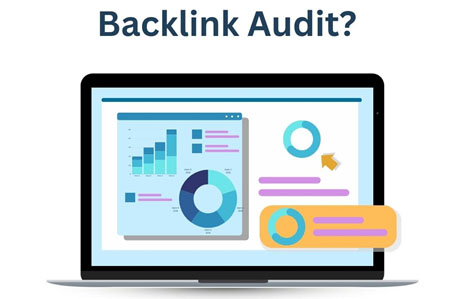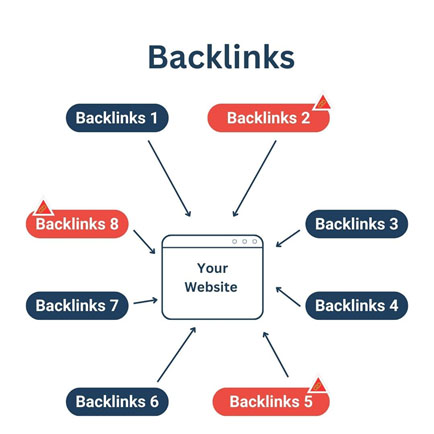Introduction
In the ever-evolving world of SEO, backlinks remain a cornerstone for building website authority and ranking higher in search results. But simply having backlinks isn’t enough. The quality and relevance of those links play a crucial role in how search engines perceive your website. This is where a Backlink Audit comes in.

A Backlink Audit is a comprehensive analysis of your website’s backlinks, uncovering their strengths and weaknesses. It helps you understand which sites are linking to you, the type of links you have, and whether any of these links might be harming your SEO efforts. While there are many powerful backlink audit tools available, Google Search Console (GSC) offers a fantastic starting point for conducting a basic but valuable audit, especially for those new to SEO.
Why conduct a backlink audit with GSC?
Before diving into the nitty-gritty of using GSC for a backlink audit, let’s explore why this process is essential for your SEO strategy.

- Identify Toxic Backlinks: Not all backlinks are created equal. Low-quality or spammy links from irrelevant websites can actually hurt your website’s ranking. A backlink audit helps you uncover these “toxic” links so you can take steps to disavow them (basically, tell Google to ignore them).
- Uncover Link Building Opportunities: A backlink audit can reveal websites that are linking to your competitors but not to you. This presents a golden opportunity to reach out to these websites and build valuable backlinks for your own site.
- Assess Link Profile Strength: By analyzing the quality and quantity of your backlinks, you can gain a better understanding of your overall website authority. This helps you benchmark your progress and identify areas where you can improve your link-building efforts.
- Stay Compliant with Google’s Guidelines: Google frowns upon manipulative link-building tactics. A backlink audit helps you ensure your link profile is clean and adheres to Google’s Webmaster Guidelines.
Unleashing the power of GSC for backlink audits
Now that you understand the importance of backlink audits, let’s explore how to leverage GSC to conduct your own.
Getting Started with GSC:
1. Verify Your Website: If you haven’t already, verify your website ownership in Google Search Console. This is a straightforward process that involves adding a verification code to your website’s code or using other methods like uploading an HTML file.
2. Navigate to the Links Report: Once verified, head over to the “Links” section in GSC. This section provides valuable insights into your website’s backlink profile.
Decoding the GSC Links Report:
The Links report in GSC is divided into four key sections:
1. Top Linked Pages (External): This section showcases the pages on your website that have received the most backlinks from external websites. Analyzing this data helps you identify which content is resonating with other websites and potentially inspiring them to link back to you.
2. Top Linking Sites (External): This section sheds light on the websites that are linking to your site the most. Here’s where the true power of a backlink audit with GSC unfolds.
- Analyze Link Quality: Look for websites that are relevant to your niche and have a good reputation. Backlinks from high-quality, authoritative websites carry more weight with search engines compared to links from spammy or irrelevant sites. Tools like MozBar or Ahrefs can provide additional insights into a website’s Domain Authority (DA) to gauge its authority.
- Identify Link Types: Not all backlinks are created equal. Here’s a breakdown of some common link types and their impact:
- Dofollow Links: These are the most valuable backlinks, as they pass link juice (SEO value) to your website.
- Nofollow Links: These links don’t directly pass link juice but can still be beneficial for driving referral traffic and brand awareness.
GSC doesn’t differentiate between dofollow and nofollow links. However, analyzing the context of the link and the linking website can give you a good idea of the link type.
- Unearth Link Building Opportunities: By identifying websites that link to your competitors but not to you, you can uncover potential link-building prospects. Analyze the content on these websites and explore opportunities to create high-quality content that they might find valuable enough to link to.
3. Top Linking Text (External): This section showcases the most common anchor text phrases used in the links pointing to your website. Anchor text is the clickable text displayed in a hyperlink.
- Maintain Natural Anchor Text Distribution: A natural distribution of anchor text phrases is crucial. If your backlinks all use the same exact anchor text (like your brand name), it can trigger red flags with Google and be interpreted as manipulative link-building. Aim for a healthy mix of anchor texts that include your brand name, relevant keywords, and variations of those keywords.
4. Top Linked Pages (Internal): While not directly related to backlink audits, this section offers valuable insights into your website’s internal linking structure. Analyzing which internal pages receive the most links from other pages within your website helps you understand how effectively your website’s content is interconnected. Strategic internal linking can help distribute link equity (SEO value) throughout your website and improve the user experience by guiding visitors to relevant content.
Taking action after your GSC backlink audit
Once you’ve completed your backlink audit using GSC, it’s time to take action based on your findings. Here are the key steps:
- Disavow Toxic Backlinks: If you’ve identified any low-quality or spammy backlinks, you can submit a disavow file to Google using the Google Disavow Tool (https://support.google.com/webmasters/answer/2648487?hl=en). This essentially tells Google to ignore these links when evaluating your website’s SEO ranking.
- Build High-Quality Backlinks: Now that you have a better understanding of your link profile and have potentially disavowed harmful links, it’s time to focus on building high-quality backlinks. Here are some strategies:
- Create High-Quality Content: Exceptional content naturally attracts backlinks.
- Guest Blogging: Contribute valuable guest posts to relevant websites in your niche.
- Broken Link Building: Find broken links on relevant websites and offer your content as a replacement.
- Online PR and Outreach: Build relationships with journalists and bloggers in your industry who might be interested in mentioning your website in their content.
- Monitor Your Backlink Profile Regularly: Backlinks are dynamic. Websites go down, and link profiles evolve over time. Regularly revisit the Links report in GSC to stay updated on your backlink profile and identify any new issues that might require attention.
Advanced backlink analysis techniques with GSC
While GSC offers a solid foundation for a backlink audit, there are additional techniques you can leverage to extract even more insights:
- Filtering by Date: The Links report allows you to filter backlinks by date range. This can be helpful for identifying new backlinks or sudden drops in backlinks, potentially indicating link removal or website takedowns. Analyze these trends and investigate potential causes to maintain a healthy backlink profile.
- Exporting Backlink Data: GSC allows you to download the backlink data for further analysis in external tools. This downloaded data provides a more comprehensive view of your backlinks, including anchor text, link types, and external page URLs. Tools like Google Sheets or Excel can then be used to perform advanced filtering, sorting, and analysis to uncover deeper patterns within your backlink profile.
- Leveraging Google Search Console Insights: Beyond the Links report, explore other sections within GSC that can provide valuable insights for your backlink audit. The “Manual Actions” section can highlight any penalties your website might have incurred due to unnatural link-building practices.
The “Search Analytics” report, while not directly related to backlinks, can reveal valuable information about organic traffic sources. By analyzing which keywords are driving the most organic traffic, you can identify potential link-building opportunities by targeting websites that rank for those same keywords.
Prioritizing backlink disavowal decisions
Disavowing backlinks is a delicate process. Not all low-quality links require disavowal. Here’s a framework for prioritizing which links to disavow:
- Spammy Links: Links from websites with irrelevant content, excessive ads, or a history of spam are prime candidates for disavowal.
- Link Farms: These are networks of websites designed solely to pass link juice. Backlinks from link farms are typically flagged by GSC or backlink analysis tools and should be disavowed.
- Sudden Spike in Backlinks: A sudden influx of low-quality backlinks can be a sign of a negative SEO attack. Analyze these links and prioritize disavowing them to mitigate potential damage.
- Broken Links: While not necessarily harmful, broken backlinks don’t offer any SEO value. Consider reaching out to the website owner and requesting an update or removal of the broken link.
Building a sustainable link-building strategy
Building high-quality backlinks is an ongoing process. Here’s how to cultivate a sustainable link-building strategy:
- Focus on Content Quality: Exceptional content that offers unique value, insightful analysis, or in-depth research naturally attracts backlinks. Invest in creating high-quality content that resonates with your target audience and establishes you as a thought leader in your niche.
- Guest Blogging with Authority Sites: Contribute guest posts to websites with high Domain Authority (DA) and a relevant audience. This strategy not only positions you as an expert but also generates valuable backlinks to your website.
- HARO (Help a Reporter Out): HARO is a platform that connects journalists with sources. By responding to relevant HARO queries with your expertise, you can secure backlinks from high-traffic news websites.
- Broken Link Building (Advanced): This strategy involves identifying broken links on relevant websites within your niche and offering your content as a replacement. However, ensure your replacement content offers similar value and context to the original broken link.
- Building Relationships: Public relations and influencer outreach are crucial for building long-term relationships with journalists, bloggers, and industry leaders. By fostering these relationships, you increase your chances of securing organic backlinks when these influencers mention your website or content in their work.
Conclusion
A backlink audit using GSC is a fantastic starting point for understanding your website’s backlink profile. It empowers you to identify areas for improvement and strategize your link-building efforts. However, it’s important to remember that GSC’s Links report offers a basic view. Consider supplementing your backlink audit with additional tools like Ahrefs, SEMrush, or Moz to gain a more comprehensive understanding of your backlink profile, including the number of backlinks, their quality score, and the referring domains’ Domain Authority (DA).
By combining the insights from GSC with the power of these advanced tools, you can develop a robust link-building strategy that propels your website towards higher rankings and greater online visibility. Remember, building high-quality backlinks is a continuous process, not a one-time fix. Regularly auditing your backlinks and implementing strategic link-building tactics is a recipe for long-term SEO success.